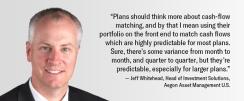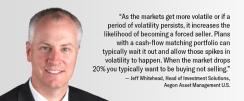Every existing defined benefit (DB) pension plan will likely face cash flow challenges in the future if they aren’t already facing them now. There are obligations to meet and bills to pay, and while some plans know they are headed toward a pension risk transfer at some point, others aren’t so sure, and must effectively address what lies between today and the future.
The objective varies from plan to plan, but plans can be aided tremendously by customized cash-flow driven investment (CDI) strategies that can provide predictable and regular investment income from coupons, maturities, and paydowns over each period immediately prior to a required cash outflow.
How pension plans can benefit from the customization of CDI strategies was the topic of the day when II spoke recently to Jeff Whitehead, Head of Investment Solutions, at Aegon Asset Management U.S.
Many plans are already cash flow negative – what’s the future look like for those that aren’t there yet?
All DB plans will likely be cash flow negative eventually, but it’s important to understand that being cash flow negative isn’t an indication of a plan’s health. Even a very well-funded plan can be cash-flow negative – it’s simply the nature of aging population demographics. There are more retirees living longer and collecting benefits. On top of that, most corporate plans are closed or frozen, which means contributions to the plan are limited.
So, what can plans do about the eventuality that they’ll be cash-flow negative?
It requires a new mindset and perspective – thinking through new strategies instead of raising money every quarter to pay out benefits.
Some public funds, for example, still receive large contributions from their active participants, but then have to pay it right back out. Being in constant money-raising mode can create problems for the health of the plan – for example, selling assets when the markets are depressed or distressed. You never want to be a forced seller.
What does the new mindset you mentioned take into account?
For starters, plans should start talking about liquidity management with their consultants in the context of their fixed income allocation. It isn’t necessarily that the plans need to hold more cash, or sell short-term or intermediate-term bonds every quarter. We also don’t necessarily think that means less fixed income, but rather using that fixed income in a better way – using it as a part of an expanded liquidity toolkit.

Tell us more about the better way, please.
I believe plans should think more about cash-flow matching, and by that I mean using their portfolio on the front end to match cash flows which are highly predictable for most plans. Sure, there’s some variance from month to month, and quarter to quarter, but they’re generally predictable, especially for larger plans. That means we can build portfolios designed to pay out a specific amount a month in advance, for example, so that plans have cash to pay benefits when they’re due and then roll that cash-flow match forward over time. That helps provide plans with the flexibility to decide to sell when it makes sense to sell.
Do you find that plans are comfortable with that idea?
Yes, most of the time, but it takes some time to think through the benefits and address the questions. As I mentioned earlier, it does require a mindset change for the plans, and perhaps a bigger one for some of the consultants.
Plans tend to hone in more on the softer benefits. Nobody ever wants to be a forced seller but most cash-flow negative plans sell assets on a quarterly basis in spite of market conditions. Many investment committees spend time each quarter deciding what to sell.
Although the longest expansion in US history is ongoing, there have been some difficult quarters in the past few years. If you think back to the ’08 financial crisis, Treasuries couldn’t move low enough in yield to offset the widening spreads in investment grade credit. A forced seller in that environment would be taking losses regardless of what they owned.
Having a strategy designed to avert that forced selling helps make investment committees and trustees more comfortable – and it’s a terrific message for plan participants to hear that their company is taking necessary action to help alleviate any concerns of them getting their monthly checks.
Is the CDI approach you’re describing nuanced depending on the size or type of plan?
Yes, that’s a key distinction. Corporate plans, because they tend to discount at high-quality bond rates, are thinking about LDI [liability driven investing]. Public plans often discount at their expected earned rate on assets. In addition, public plans are typically open and accruing benefits. So very different mindsets.
On the corporate side, you can use cash-flow matching on the front end in conjunction with LDI, and that’s what we see happening a lot in the UK. We have clients in the U.S. who are fully funded and hibernated and like that approach. Eventually, they plan to buy annuities from an insurance company, but for now they’re still managing the plan on an ongoing basis. They use LDI in an effort to neutralize interest rate risk and include CDI in their LDI strategy to help manage benefit payments.
Most public plans aren’t currently pursuing LDI strategies. They’re doing what they’ve always done – large allocations to equities and alternatives, with fixed income as a source of diversification. We agree with that approach but believe many plans should make their fixed income allocation work harder.

It’s widely expected that volatility spikes may be more frequent and prolonged over the next few years. What does that mean for plans in the cash flow struggle?
I believe it makes CDI strategies more important. As the markets get more volatile or if a period of volatility persists, it increases the likelihood of becoming a forced seller. Plans with a cash-flow matching portfolio can typically wait it out and allow those spikes in volatility to happen. When the market drops 20% you typically want to be buying not selling. If you have a large enough cash-flow matching portfolio, you could have the opportunity to be a buyer of equities when the equity markets have experienced a sharp downturn.
Where does the customization of CDI strategies fit in?
Customization is essential to the success of a CDI strategy. Some plans are more cash-flow negative than others and they all have varying risk tolerances, which is why each portfolio is uniquely structured to meet a plan’s specific situation.
Part of the customization is that the sizing of the portfolio is flexible, meaning a plan can match 18 months or two years of cash flows if that’s what’s needed. We’ve even seen plans match four years. Plans can go as far out or as short as they want.
What’s the advantage of working with you and your team at Aegon on CDI strategies?
When constructing a CDI portfolio, we take a multi-sector approach to fixed income, so we’re not using only investment grade (IG) credit. We minimize the use of Treasury bonds. We are a shop focused on fundamental, bottom-up research. We invest in high yield, emerging market debt, and various structured securities, in addition to the IG credit. One of our strengths is our depth of expertise within our research teams, which helps us identify opportunities in crowded markets. Cash flow matching is not difficult, but it should be married with the generation of risk-adjusted returns.
You mentioned securitized credit. It sounds as if you’re not limiting yourself to what might be included in this strategy.
Right, we use asset-backed securities [ABS] of all flavors including esoteric ABS, and commercial mortgage-backed securities [CMBS]. And then to the extent we can find good value in non-agency residential mortgage-backed securities [RMBS], we utilize that sector as well.
So, no, we don’t tend to limit ourselves, and there are different approaches to duration. If the size of the portfolio is large enough, we may buy longer bonds. So, even though we’re talking about a front-end, cash-flow matching concept, a lot of that is with income. For longer maturities, we tend to focus on higher quality issuers.
And you have to accomplish all of this without taking excessive risk, correct?
We’ll meet with the plan sponsor’s investment committee and talk about their risk profile and, if they are willing to take a little bit more risk on the front end and in high-yield sectors, we can construct a portfolio designed to provide a bit more yield than they’re currently getting in their fixed income portfolio. If they’re benchmarked against the Bloomberg Barclays Aggregate Index, for example, for a core or even a core plus mandate, we can dial risk up or down in the CDI portfolio, which allows us to vary the expected yield of the portfolio.
At the same time, we tend to use a lot of the same sectors as an aggregate index, so we’re still pursuing diversification relative to the equities and the alts many plans have in their portfolio. But that’s why they’re using fixed income in the first place. Said a different way, we don’t intend to give up diversification, we’re just using that portfolio differently, repurposing fixed income, while still focused on maintaining diversification.
Sounds as if using that portfolio differently is something like the new mindset you’ve mentioned for investors and consultants.
That’s right. We can’t expect investors to adopt a new mindset if we’re not willing to ourselves, and that’s reflected in our strategies.
Learn more about the benefits of a customized CDI strategy.
Disclosures
Aegon Asset Management US is a US-based SEC registered investment adviser and is also registered as a Commodity Trading Advisor (CTA) with the Commodity Futures Trading Commission (CFTC) and is a member of the National Futures Association (NFA). Aegon Asset Management US is part of Aegon Asset Management, the global investment management brand of the Aegon Group.
The information contained in this article is for informational purposes only and should not be considered investment advice or a recommendation of any particular security, strategy or investment product. The article contains the current opinions of the author and is accurate as of the date of the article. Such opinions are subject to change without notice. The author is under no obligation, expressed or implied, to update the material contained herein.
This article contains forward-looking statements which are based on the author’s beliefs, as well as on a number of assumptions concerning future events, based on information currently available to the author. These statements involve certain risks, uncertainties and assumptions which are difficult to predict. Consequently, such statements cannot be guarantees of future performance, and actual outcomes and returns may differ materially from statements set forth herein.
There is no guarantee these investment or portfolio strategies will work under all market conditions or are suitable for all investors and each investor should evaluate their ability to invest over the long-term, especially during periods of increased market volatility. All investments contain risk and may lose value. Investors should consult their investment professional prior to making an investment decision.






